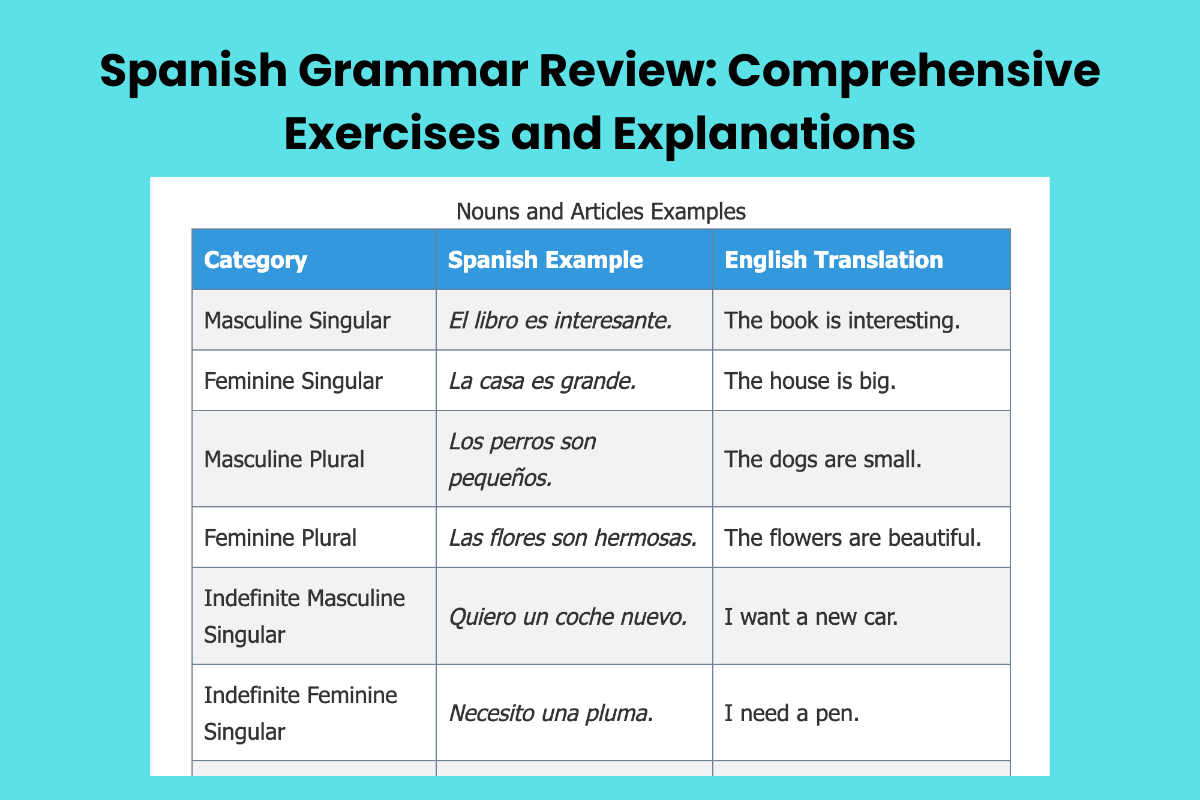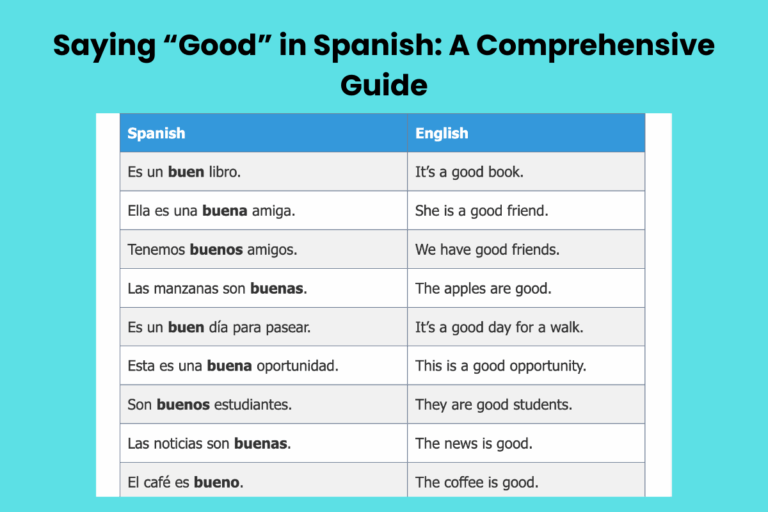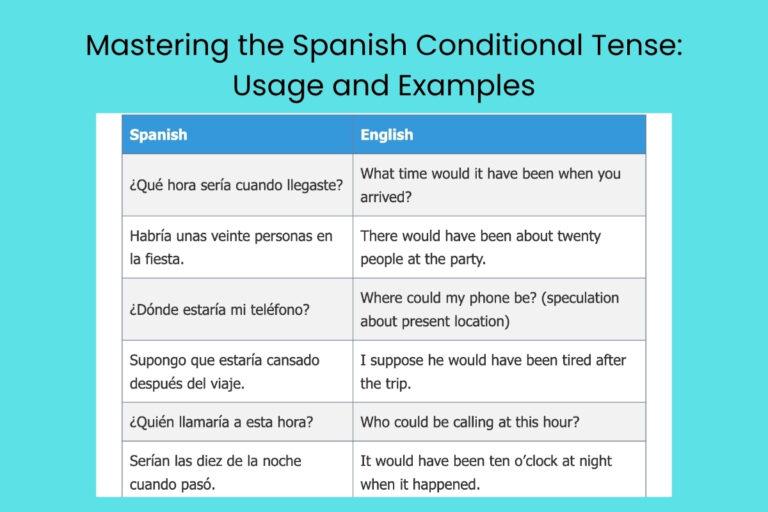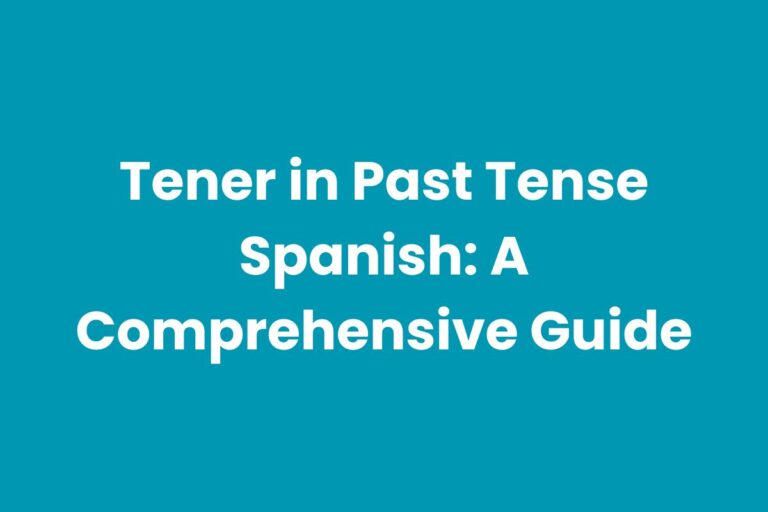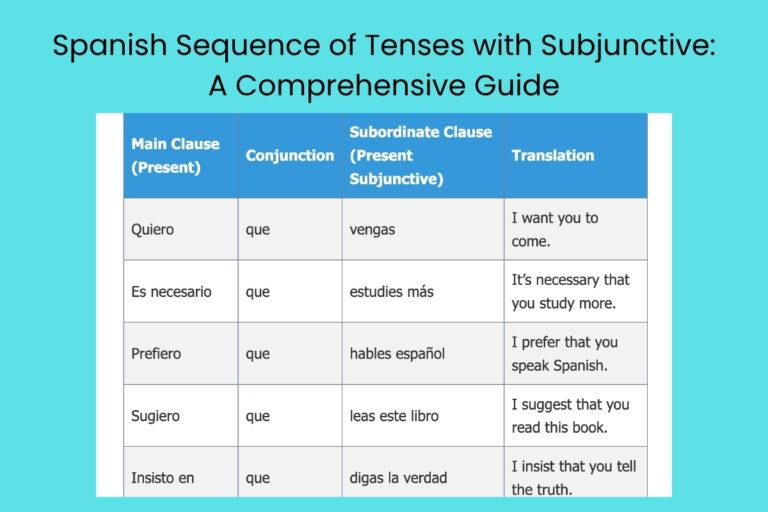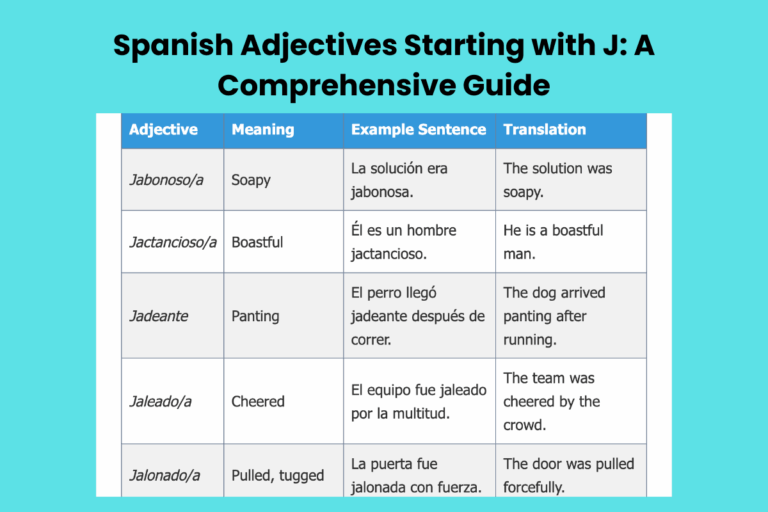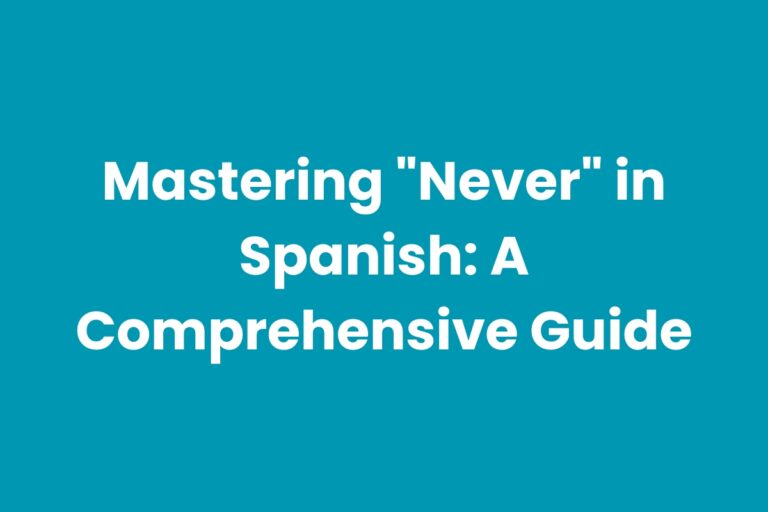Spanish Grammar Review: Comprehensive Exercises and Explanations
Mastering Spanish grammar is crucial for effective communication and comprehension. This article provides a comprehensive review of essential Spanish grammar concepts through detailed explanations and practical exercises.
Whether you’re a beginner or an advanced learner, this guide will help you solidify your understanding of Spanish grammar and improve your fluency. By working through these exercises, you’ll gain confidence in your ability to use Spanish accurately and naturally, paving the way for more meaningful conversations and deeper engagement with the Spanish-speaking world.
Table of Contents
- Introduction
- Definition of Spanish Grammar
- Structural Breakdown of Spanish Grammar
- Nouns and Articles
- Adjectives
- Verbs
- Pronouns
- Adverbs
- Prepositions
- Sentence Structure
- Examples
- Usage Rules
- Common Mistakes
- Practice Exercises
- Advanced Topics
- FAQ
- Conclusion
Introduction
Spanish grammar, like any language’s grammar, provides the framework for constructing meaningful sentences and conveying ideas effectively. A solid grasp of Spanish grammar is essential for both understanding spoken and written Spanish and expressing oneself clearly and accurately.
This comprehensive guide offers a thorough review of key grammatical concepts, designed to help learners of all levels strengthen their skills. From the foundational elements of nouns and articles to more complex topics like the subjunctive mood and advanced sentence structures, we’ll explore the intricacies of Spanish grammar in a clear and accessible way.
Through detailed explanations, numerous examples, and practical exercises, you’ll gain the confidence to tackle even the most challenging grammatical concepts.
This article is designed for a wide range of learners, including beginners seeking a solid foundation, intermediate students looking to refine their understanding, and advanced speakers aiming to perfect their grammar. We’ll delve into the core components of Spanish grammar, providing detailed explanations and practical exercises to reinforce your learning.
Whether you are preparing for an exam, traveling to a Spanish-speaking country, or simply aiming to enhance your linguistic skills, this guide will serve as a valuable resource on your journey to Spanish fluency.
Definition of Spanish Grammar
Spanish grammar encompasses the rules and principles governing the structure of the Spanish language. It includes the morphology (word formation), syntax (sentence structure), and phonology (sound system) that dictate how words are combined to form grammatically correct and meaningful sentences.
Understanding Spanish grammar is crucial for both comprehending and producing accurate and fluent Spanish.
At its core, Spanish grammar is a system of rules that dictate how words are formed (morphology), how they are arranged in sentences (syntax), and how they relate to each other. These rules cover various aspects of the language, including the use of nouns, articles, adjectives, verbs, adverbs, pronouns, and prepositions.
Mastering these elements is essential for building a strong foundation in Spanish and achieving effective communication.
Structural Breakdown of Spanish Grammar
The structure of Spanish grammar can be broken down into several key components, each playing a vital role in constructing well-formed sentences. These components include:
- Nouns and Articles: Nouns are words that represent people, places, things, or ideas. Articles are used to specify whether a noun is definite (specific) or indefinite (general).
- Adjectives: Adjectives describe nouns and must agree in gender and number with the nouns they modify.
- Verbs: Verbs express actions, states, or occurrences. Spanish verbs are highly inflected, meaning they change form to indicate tense, mood, person, and number.
- Pronouns: Pronouns replace nouns to avoid repetition. They include subject pronouns, object pronouns, reflexive pronouns, possessive pronouns, and demonstrative pronouns.
- Adverbs: Adverbs modify verbs, adjectives, or other adverbs, providing information about how, when, where, or to what extent an action is performed.
- Prepositions: Prepositions connect nouns, pronouns, or phrases to other words in a sentence, indicating relationships such as location, direction, time, or cause.
- Sentence Structure: The typical sentence structure in Spanish is Subject-Verb-Object (SVO), although variations are common.
Nouns and Articles
Noun Gender
In Spanish, nouns have a gender: masculine or feminine. This gender is often, but not always, related to the biological sex of the person or animal the noun represents. Generally, nouns ending in -o are masculine, and nouns ending in -a are feminine. However, there are exceptions to this rule.
Understanding noun gender is crucial because it affects the form of articles, adjectives, and pronouns that modify or refer to the noun. Incorrect gender usage can lead to grammatical errors and confusion.
Noun Number
Nouns in Spanish also have a number: singular or plural. To form the plural of most nouns, add -s if the noun ends in a vowel, and -es if the noun ends in a consonant. There are also some irregular plural forms.
Like gender, noun number affects the agreement of articles, adjectives, and pronouns. Ensuring correct number agreement is essential for grammatical accuracy.
Definite Articles
Definite articles (el, la, los, las) are used to refer to specific nouns or nouns that have already been mentioned. The choice of definite article depends on the gender and number of the noun.
- el – masculine singular
- la – feminine singular
- los – masculine plural
- las – feminine plural
For example: el libro (the book), la mesa (the table), los libros (the books), las mesas (the tables).
Indefinite Articles
Indefinite articles (un, una, unos, unas) are used to refer to non-specific nouns or nouns that are being mentioned for the first time. The choice of indefinite article also depends on the gender and number of the noun.
- un – masculine singular
- una – feminine singular
- unos – masculine plural
- unas – feminine plural
For example: un libro (a book), una mesa (a table), unos libros (some books), unas mesas (some tables).
Adjectives
Adjective Agreement
Adjectives in Spanish must agree in gender and number with the nouns they modify. This means that the adjective’s ending must match the gender and number of the noun.
For example: el libro rojo (the red book), la mesa roja (the red table), los libros rojos (the red books), las mesas rojas (the red tables).
Adjective Placement
In Spanish, adjectives usually follow the noun they modify. However, some adjectives, such as those indicating quantity or opinion, often precede the noun.
For example: un coche nuevo (a new car), una casa grande (a big house), but muchos libros (many books), buen día (good day).
Comparative and Superlative Adjectives
Comparative adjectives are used to compare two things. The most common way to form the comparative is by using más (more) or menos (less) before the adjective.
For example: más alto que (taller than), menos interesante que (less interesting than).
Superlative adjectives are used to indicate the highest degree of a quality. The most common way to form the superlative is by using el/la/los/las más/menos before the adjective.
For example: el más alto (the tallest), la menos interesante (the least interesting).
Verbs
Verb Conjugation
Verb conjugation is a fundamental aspect of Spanish grammar. Spanish verbs change form depending on the tense, mood, person, and number. Each verb belongs to one of three conjugations, based on the infinitive ending: -ar, -er, or -ir.
Understanding verb conjugations is essential for constructing grammatically correct sentences and expressing actions accurately.
Regular Verbs
Regular verbs follow predictable conjugation patterns. By learning the regular verb endings for each tense and conjugation, you can conjugate most verbs correctly.
For example, the regular -ar verb hablar (to speak) is conjugated as follows in the present tense:
- yo hablo (I speak)
- tú hablas (you speak)
- él/ella/usted habla (he/she/you speak)
- nosotros/nosotras hablamos (we speak)
- vosotros/vosotras habláis (you speak)
- ellos/ellas/ustedes hablan (they/you speak)
Irregular Verbs
Irregular verbs do not follow the standard conjugation patterns. These verbs often have stem changes or irregular endings in certain tenses. Common irregular verbs include ser (to be), estar (to be), tener (to have), ir (to go), and hacer (to do/make).
Memorizing the conjugations of irregular verbs is crucial for fluency in Spanish.
Ser vs. Estar
The verbs ser and estar both mean “to be” in English, but they are used in different contexts. Ser is used to describe permanent or inherent characteristics, such as identity, origin, nationality, and physical attributes. Estar is used to describe temporary states, conditions, emotions, and locations.
Understanding the difference between ser and estar is essential for accurate and natural Spanish.
Preterite vs. Imperfect
The preterite and imperfect are two past tenses in Spanish. The preterite is used to describe completed actions in the past, while the imperfect is used to describe ongoing or habitual actions in the past.
Choosing the correct past tense depends on the context and the intended meaning.
Subjunctive Mood
The subjunctive mood is used to express doubt, uncertainty, wishes, emotions, and opinions. It is often used in subordinate clauses that are introduced by conjunctions such as que (that), si (if), cuando (when), and para que (so that).
Mastering the subjunctive mood is essential for expressing nuanced meanings and complex ideas in Spanish.
Pronouns
Subject Pronouns
Subject pronouns replace the subject of a sentence. The Spanish subject pronouns are:
- yo (I)
- tú (you, informal)
- él (he)
- ella (she)
- usted (you, formal)
- nosotros/nosotras (we)
- vosotros/vosotras (you, informal plural, mainly used in Spain)
- ellos/ellas (they)
- ustedes (you, formal plural)
In Spanish, subject pronouns are often omitted because the verb conjugation indicates the subject. However, they are used for emphasis or to avoid ambiguity.
Object Pronouns
Object pronouns replace the direct or indirect object of a sentence. Direct object pronouns receive the action of the verb, while indirect object pronouns indicate to whom or for whom the action is performed.
The object pronouns are:
- me (me)
- te (you, informal)
- lo/la (him/her/it)
- nos (us)
- os (you, informal plural)
- los/las (them)
- le (to him/her/you, formal)
- les (to them/you, formal plural)
Object pronouns usually precede the verb in Spanish, except in affirmative commands and when used with infinitives or gerunds.
Reflexive Pronouns
Reflexive pronouns are used when the subject and object of a verb are the same. They indicate that the action of the verb is performed on the subject itself.
The reflexive pronouns are:
- me (myself)
- te (yourself, informal)
- se (himself/herself/itself/yourself, formal)
- nos (ourselves)
- os (yourselves, informal plural)
- se (themselves/yourselves, formal plural)
Reflexive pronouns are used with reflexive verbs, which describe actions that people do to themselves, such as lavarse (to wash oneself) or despertarse (to wake up).
Possessive Pronouns
Possessive pronouns replace nouns and indicate ownership. The possessive pronouns are:
- mío/mía/míos/mías (mine)
- tuyo/tuya/tuyos/tuyas (yours, informal)
- suyo/suya/suyos/suyas (his/hers/its/yours, formal)
- nuestro/nuestra/nuestros/nuestras (ours)
- vuestro/vuestra/vuestros/vuestras (yours, informal plural)
- suyo/suya/suyos/suyas (theirs/yours, formal plural)
Possessive pronouns agree in gender and number with the noun they replace.
Demonstrative Pronouns
Demonstrative pronouns point out specific nouns. The demonstrative pronouns are:
- éste/ésta/éstos/éstas (this/these)
- ése/ésa/ésos/ésas (that/those)
- aquél/aquélla/aquéllos/aquéllas (that/those over there)
Demonstrative pronouns agree in gender and number with the noun they point out.
Adverbs
Types of Adverbs
Adverbs modify verbs, adjectives, or other adverbs, providing information about how, when, where, or to what extent an action is performed. There are several types of adverbs, including:
- Adverbs of Manner: Describe how an action is performed (e.g., rápidamente – quickly, lentamente – slowly).
- Adverbs of Time: Indicate when an action occurs (e.g., hoy – today, mañana – tomorrow, ayer – yesterday).
- Adverbs of Place: Specify where an action takes place (e.g., aquí – here, allí – there, cerca – near).
- Adverbs of Degree: Indicate the intensity or extent of an action or quality (e.g., muy – very, poco – little, mucho – much).
- Adverbs of Frequency: Describe how often an action occurs (e.g., siempre – always, nunca – never, a menudo – often).
Adverb Formation
Many adverbs in Spanish are formed by adding the suffix -mente to the feminine singular form of an adjective. For example, the adjective rápida (quick) becomes the adverb rápidamente (quickly).
If an adjective already ends in -e, the -mente suffix is added directly (e.g., fácil – easy, fácilmente – easily).
Adverb Placement
Adverbs are generally placed after the verb they modify. However, adverbs of time and place can often be placed at the beginning of a sentence for emphasis.
For example: Ella habla rápidamente (She speaks quickly), Hoy voy al cine (Today I am going to the cinema).
Prepositions
Prepositions connect nouns, pronouns, or phrases to other words in a sentence, indicating relationships such as location, direction, time, or cause. Common Spanish prepositions include:
- a (to, at)
- de (of, from)
- en (in, on, at)
- con (with)
- para (for, in order to)
- por (for, by, through)
- sin (without)
- sobre (on, about)
- entre (between, among)
- hacia (toward)
- hasta (until, up to)
Understanding the correct usage of prepositions is crucial for constructing grammatically correct and meaningful sentences.
Sentence Structure
The basic sentence structure in Spanish is Subject-Verb-Object (SVO), similar to English. However, Spanish allows for more flexibility in word order, and the subject is often omitted because the verb conjugation indicates the subject.
For example: Yo como manzanas (I eat apples), but also Como manzanas (I eat apples).
In questions, the subject and verb can be inverted, or the question can be indicated by intonation alone.
For example: ¿Comes manzanas? (Do you eat apples?) or ¿Tú comes manzanas? (Do you eat apples?).
Examples
This section provides various examples illustrating the key grammar concepts discussed above. These examples are organized by grammatical category to help you understand how each concept is applied in real-world contexts.
| Category | Spanish Example | English Translation |
|---|---|---|
| Masculine Singular | El libro es interesante. | The book is interesting. |
| Feminine Singular | La casa es grande. | The house is big. |
| Masculine Plural | Los perros son pequeños. | The dogs are small. |
| Feminine Plural | Las flores son hermosas. | The flowers are beautiful. |
| Indefinite Masculine Singular | Quiero un coche nuevo. | I want a new car. |
| Indefinite Feminine Singular | Necesito una pluma. | I need a pen. |
| Indefinite Masculine Plural | Hay unos niños jugando. | There are some children playing. |
| Indefinite Feminine Plural | Compré unas manzanas. | I bought some apples. |
| Noun Gender Exception | El mapa es antiguo. | The map is old. |
| Noun Number Exception | El lunes es mi día libre. | Monday is my day off. |
| Masculine Singular | El problema es difícil. | The problem is difficult. |
| Feminine Singular | La situación es complicada. | The situation is complicated. |
| Masculine Plural | Los estudiantes son inteligentes. | The students are intelligent. |
| Feminine Plural | Las preguntas son importantes. | The questions are important. |
| Indefinite Masculine Singular | Vi un pájaro en el árbol. | I saw a bird in the tree. |
| Indefinite Feminine Singular | Compré una camisa nueva. | I bought a new shirt. |
| Indefinite Masculine Plural | Hay unos libros sobre la mesa. | There are some books on the table. |
| Indefinite Feminine Plural | Necesito unas gafas de sol. | I need some sunglasses. |
| Noun Gender Exception | El clima es agradable. | The weather is pleasant. |
| Noun Number Exception | El martes tengo una reunión. | On Tuesday I have a meeting. |
| Masculine Singular | El coche es rápido. | The car is fast. |
| Feminine Singular | La noche es oscura. | The night is dark. |
| Masculine Plural | Los árboles son altos. | The trees are tall. |
| Feminine Plural | Las estrellas son brillantes. | The stars are bright. |
| Category | Spanish Example | English Translation |
|---|---|---|
| Adjective Agreement | El hombre alto. | The tall man. |
| Adjective Agreement | La mujer alta. | The tall woman. |
| Adjective Agreement | Los hombres altos. | The tall men. |
| Adjective Agreement | Las mujeres altas. | The tall women. |
| Adjective Placement | Un buen día. | A good day. |
| Adjective Placement | Una casa grande. | A big house. |
| Comparative | Soy más alto que tú. | I am taller than you. |
| Superlative | Es el coche más rápido. | It is the fastest car. |
| Adjective Agreement | El libro interesante. | The interesting book. |
| Adjective Agreement | La película interesante. | The interesting movie. |
| Adjective Agreement | Los libros interesantes. | The interesting books. |
| Adjective Agreement | Las películas interesantes. | The interesting movies. |
| Adjective Placement | Un nuevo comienzo. | A new beginning. |
| Adjective Placement | Una vieja amiga. | An old friend. |
| Comparative | Es menos caro que eso. | It’s less expensive than that. |
| Superlative | Es la mejor opción. | It’s the best option. |
| Adjective Agreement | El café caliente. | The hot coffee. |
| Adjective Agreement | La sopa caliente. | The hot soup. |
| Adjective Agreement | Los cafés calientes. | The hot coffees. |
| Adjective Agreement | Las sopas calientes. | The hot soups. |
| Category | Spanish Example | English Translation |
|---|---|---|
| Regular Verb (Present) | Yo hablo español. | I speak Spanish. |
| Irregular Verb (Present) | Yo soy estudiante. | I am a student. |
| Ser vs. Estar | Soy de España. | I am from Spain. |
| Ser vs. Estar | Estoy cansado. | I am tired. |
| Preterite | Ayer comí pizza. | Yesterday I ate pizza. |
| Imperfect | Cuando era niño, jugaba mucho. | When I was a child, I used to play a lot. |
| Subjunctive | Espero que vengas. | I hope you come. |
| Regular Verb (Present) | Tú cantas bien. | You sing well. |
| Irregular Verb (Present) | Él tiene un coche. | He has a car. |
| Ser vs. Estar | Ella es doctora. | She is a doctor. |
| Ser vs. Estar | Estamos en casa. | We are at home. |
| Preterite | Visitamos Madrid el año pasado. | We visited Madrid last year. |
| Imperfect | Siempre íbamos al parque. | We always used to go to the park. |
| Subjunctive | Quiero que seas feliz. | I want you to be happy. |
| Regular Verb (Present) | Nosotros vivimos aquí. | We live here. |
| Irregular Verb (Present) | Ellos hacen la tarea. | They do the homework. |
| Ser vs. Estar | Ellos son profesores. | They are teachers. |
| Ser vs. Estar | Está lloviendo. | It is raining. |
| Preterite | Escribí una carta ayer. | I wrote a letter yesterday. |
| Imperfect | Antes leía muchos libros. | Before, I used to read many books. |
| Subjunctive | Es importante que estudies. | It’s important that you study. |
Usage Rules
This section outlines the key rules governing the proper use of Spanish grammar, including exceptions and special cases. Adhering to these rules is essential for achieving accuracy and fluency in Spanish.
Noun-Adjective Agreement: Adjectives must agree in gender and number with the nouns they modify. For example, el coche rojo (the red car) and la casa roja (the red house).
Verb Conjugation: Verbs must be conjugated correctly to match the subject and tense. Understanding regular and irregular verb patterns is crucial. For example, yo hablo (I speak) and él habla (he speaks).
Ser vs. Estar: Use ser for permanent characteristics and estar for temporary states. For example, Soy alto (I am tall) and Estoy cansado (I am tired).
Preterite vs. Imperfect: Use the preterite for completed actions and the imperfect for ongoing or habitual actions in the past. For example, Comí pizza ayer (I ate pizza yesterday) and Cuando era niño, jugaba mucho (When I was a child, I used to play a lot).
Subjunctive Mood: Use the subjunctive mood to express doubt, uncertainty, wishes, and emotions. For example, Espero que vengas (I hope you come).
Object Pronoun Placement: Object pronouns usually precede the verb, except in affirmative commands and with infinitives or gerunds. For example, Me gusta (I like it) and Quiero verlo (I want to see it).
Preposition Usage: Use the correct preposition to indicate relationships such as location, direction, time, and cause. For example, Voy a la tienda (I am going to the store) and Estoy en casa (I am at home).
Common Mistakes
This section highlights common mistakes made by Spanish learners and provides correct examples to help you avoid these errors.
| Incorrect | Correct | Explanation |
|---|---|---|
| El libro es roja. | El libro es rojo. | Adjective must agree in gender with the noun. |
| Yo estoy hambre. | Yo tengo hambre. | Use tener to express hunger. |
| Hice la tarea ayer. | Hice la tarea ayer. | This sentence is already correct. |
| Quiero que tu vienes. | Quiero que tú vengas. | Use the subjunctive form of the verb after que. |
| Me gusta la libro. | Me gusta el libro. | Article must agree in gender with the noun. |
| Yo soy cansado. | Yo estoy cansado. | Use estar to express a temporary state. |
| Ayer fui a la playa y nadé. | Ayer fui a la playa y nadé. | This sentence is already correct. |
| Espero que vas. | Espero que vayas. | Use the subjunctive form of the verb after que. |
| Lo libro es mío. | El libro es mío. | Article must agree in gender with the noun. |
| Estoy feliz. | Estoy feliz. | This sentence is already correct. |
Practice Exercises
Test your knowledge with these practice exercises. Each exercise focuses on a specific grammar concept, allowing you to reinforce your understanding and identify areas for improvement.
Nouns and Articles Exercise
Fill in the blanks with the correct definite or indefinite article and noun form.
- _________ perro es pequeño. (dog)
- _________ casas son grandes. (houses)
- Quiero comprar _________ coche. (car)
- Necesito _________ plumas. (pens)
- _________ mapa es antiguo. (map)
Answers:
- El perro es pequeño.
- Las casas son grandes.
- Quiero comprar un coche.
- Necesito unas plumas.
- El mapa es antiguo.
Adjectives Exercise
Complete the sentences with the correct form of the adjective, ensuring it agrees with the noun.
- El libro es _________. (interesante)
- La casa es _________. (grande)
- Los perros son _________. (pequeño)
- Las flores son _________. (hermoso)
- Soy más _________ que tú. (alto)
Answers:
- El libro es interesante.
- La casa es grande.
- Los perros son pequeños.
- Las flores son hermosas.
- Soy más alto que tú.
Verbs Exercise
Conjugate the verb in parentheses in the correct tense and form.
- Yo _________ español. (hablar – present)
- Él _________ un coche. (tener – present)
- Ayer yo _________ pizza. (comer – preterite)
- Cuando era niño, yo _________ mucho. (jugar – imperfect)
- Espero que tú _________. (venir – subjunctive)
Answers:
- Yo hablo español.
- Él tiene un coche.
- Ayer yo comí pizza.
- Cuando era niño, yo jugaba mucho.
- Espero que tú vengas.
Pronouns Exercise
Fill in the blanks with the correct pronoun.
- _________ llamo Juan. (I)
- _________ gusta el libro. (to me)
- Ella lava _________. (herself)
- Este libro es _________. (mine)
- _________ coche es nuevo. (this)
Answers:
- Yo me llamo Juan.
- Me gusta el libro.
- Ella se lava.
- Este libro es mío.
- Este coche es nuevo.
Adverbs Exercise
Complete the sentences with the appropriate adverb.
- Ella habla _________. (rápido)
- Voy al cine _________. (hoy)
- El libro está _________. (aquí)
- Estoy _________ cansado. (muy)
- _________ voy al gimnasio. (siempre)
Answers:
- Ella habla rápidamente.
- Voy al cine hoy.
- El libro está aquí.
- Estoy muy cansado.
- Siempre voy al gimnasio.
Advanced Topics
For those looking to delve deeper into Spanish grammar, here are some advanced topics to explore:
- Conditional Tense: Learn how to express hypothetical situations and polite requests.
- Perfect Tenses: Master the use of perfect tenses to describe actions that have been completed at a specific point in time.
- Passive Voice: Understand how to use the passive voice to shift the focus from the subject to the action.
- Complex Sentence Structures: Explore advanced sentence structures, including relative clauses and conditional sentences.
- Idiomatic Expressions: Familiarize yourself with common idiomatic expressions to enhance your fluency and understanding of colloquial Spanish.
FAQ
Conclusion
Mastering Spanish grammar is a journey that requires dedication and practice. By understanding the fundamental concepts outlined in this guide and consistently working through the exercises, you can significantly improve your accuracy and fluency in Spanish.
Remember to focus on noun and adjective agreement, verb conjugation, pronoun usage, and preposition selection. With time and effort, you’ll gain the confidence to express yourself clearly and effectively in Spanish, opening up a world of new opportunities and experiences.

